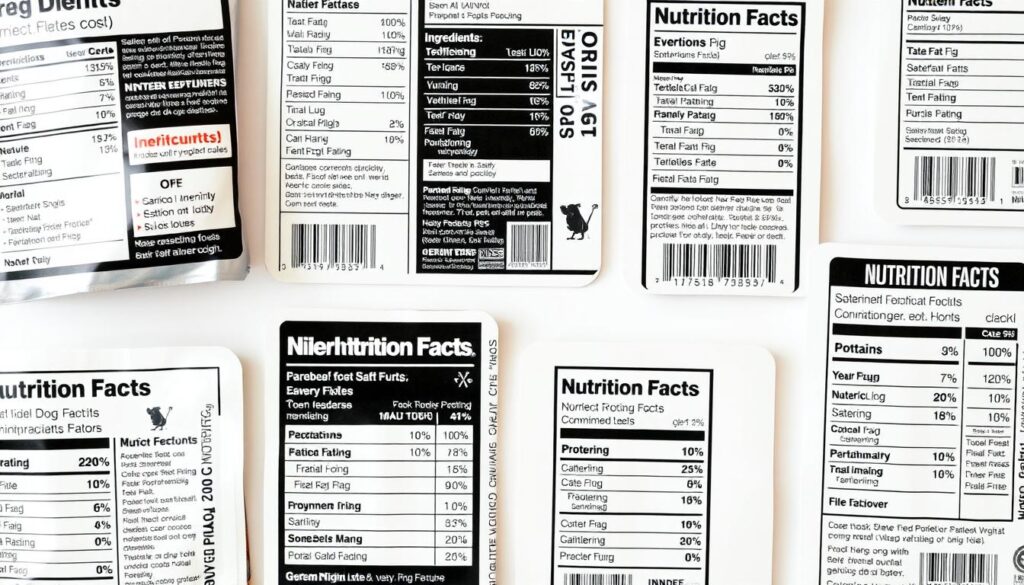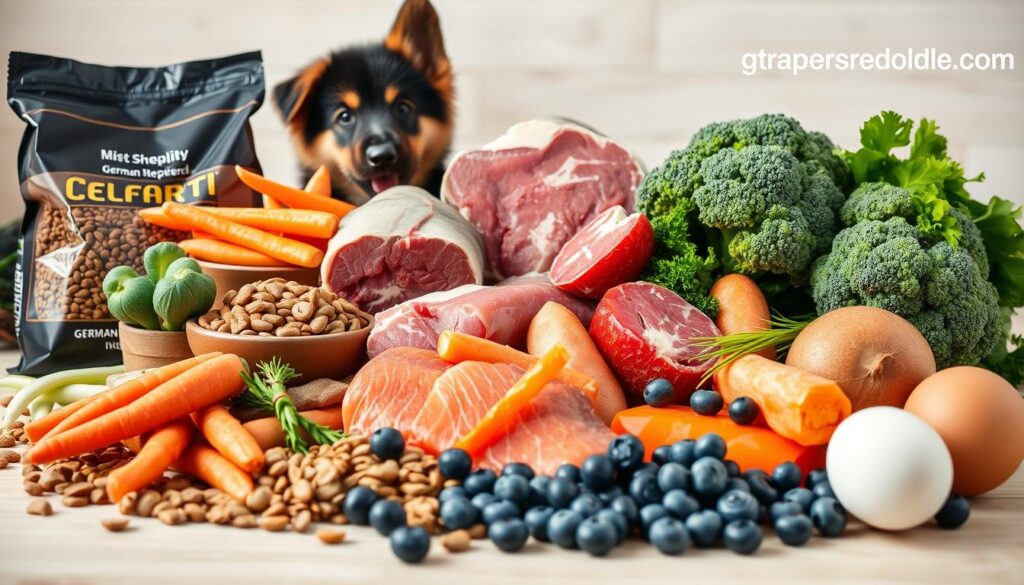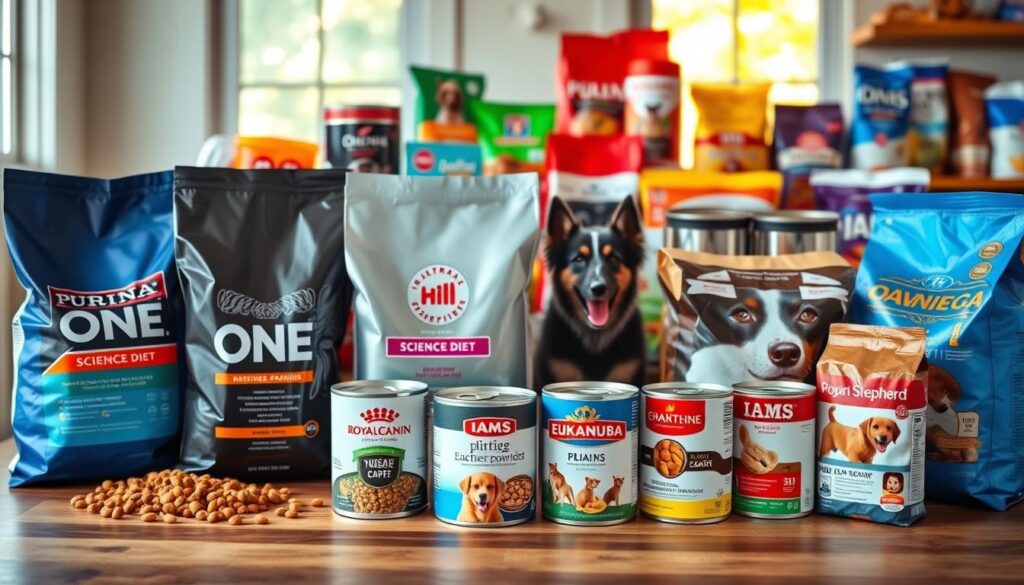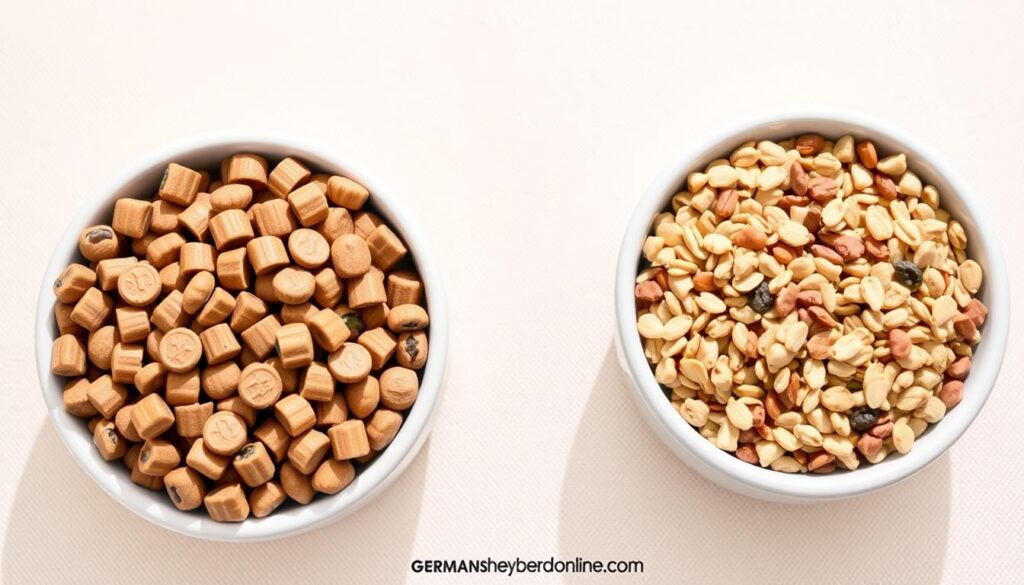Raising a loyal, energetic companion starts with understanding their unique needs. Young german shepherds require carefully balanced meals to support their rapid growth and active lifestyles. Without proper nutrients, they risk developing joint issues or other health challenges later in life.
High-quality puppy formulas prioritize safety and tailored calcium ratios. This helps prevent skeletal problems like hip dysplasia, a common concern for larger breeds. We’ll explore how specific ingredients and feeding strategies address these risks while keeping your pup energized.
Whether you prefer dry kibble or wet recipes, trusted brands offer solutions designed for developing muscles and cognitive health. Our guide compares top-rated options, breaking down protein sources, grain-free alternatives, and budget-friendly picks. Let’s ensure your furry friend gets the strong start they deserve.
Key Takeaways
- Tailored nutrition prevents growth-related health issues in large-breed puppies
- Calcium-to-phosphorus balance directly impacts bone and joint development
- Both dry and wet recipes can meet dietary needs when formulated properly
- Reputable brands prioritize species-appropriate proteins and digestible carbs
- Upcoming sections detail product comparisons and feeding schedules
Introduction
Selecting meals for your active companion involves more than grabbing any bag from the store shelf. Young large-breed dogs need targeted nutrition to thrive, but pet parents often feel overwhelmed by endless options and conflicting advice. Balancing quality ingredients with budget realities adds another layer of complexity.
Growing pups from working-line breeds require precisely calibrated formulas. Their rapid development demands higher protein levels and controlled calcium ratios compared to smaller dogs. Skimping on these elements risks long-term joint problems, while overfeeding can cause unhealthy weight gain.
We’ve sorted through veterinary research and top-rated products to simplify your decision. Our recommendations focus on digestible proteins, joint-supporting nutrients, and brands that avoid filler-heavy recipes. You’ll discover options matching various budgets without compromising your pup’s health.
Upcoming sections break down specific nutritional benchmarks and compare trusted brands. Whether you prioritize fresh ingredients or need allergy-friendly choices, we’ll help you navigate the maze. Let’s build a meal plan that keeps those playful paws moving!
Understanding the Nutritional Needs of German Shepherd Puppies
Fueling your growing companion’s potential requires more than generic puppy formulas. These active breeds experience growth spurts that demand precise nutritional support – a fact veterinary nutritionists emphasize when designing diets for working-line dogs.

Growth and Development Requirements
Between 8 weeks and 18 months, your shepherd’s bones lengthen rapidly. Research shows improper calcium ratios during this phase increase hip dysplasia risks by 42%. Leading brands like Orijen use species-appropriate proteins (chicken, turkey) to build lean muscle without excessive weight gain.
Essential Vitamins, Minerals, and Protein
High-quality animal protein provides amino acids for tissue repair. Look for recipes containing:
- 22-28% protein from named meat sources
- 1.2-1.8% calcium for skeletal density
- Omega fatty acids for brain development
Dr. Ellen Rogers, a veterinary nutritionist, notes:
“Balanced zinc and vitamin D levels act as guardians against skin issues and weak joints in large-breed puppies.”
Smart feeding strategies combine these elements to support that iconic shepherd stamina. You’ll notice improved coat shine and steadier energy levels when nutritional building blocks align with their biological needs.
Key Factors to Consider When Choosing Dog Food
Navigating the pet food aisle requires more than comparing prices. Young shepherds thrive when their meals align with breed-specific needs, making label literacy your superpower. Let’s break down two critical factors that impact long-term health and vitality.

Appropriate Calcium Levels and Joint Health
Growing pups need precise calcium ratios – too much or too little harms developing joints. Veterinary studies show 1.2-1.8% calcium content helps prevent dysplasia in large breeds. Dr. Sarah Thompson, a canine nutrition specialist, advises:
“Look for formulas listing calcium carbonate or eggshell meal. These sources absorb better than bone meal alternatives.”
Your pup’s meals should support bone density without accelerating growth. Check guaranteed analysis panels before purchasing.
Balanced Fat-to-Protein Ratio
Active shepherds need 22-28% protein with moderate fat (12-16%) for sustained energy. Chicken-based recipes often hit this sweet spot, providing lean muscle fuel. Watch for:
- Named animal proteins (like chicken meal) as first ingredients
- Omega-3 fatty acids from fish oil or flaxseed
- Limited plant-based fillers
This balance prevents obesity while supporting that signature shepherd stamina. You’ll notice steadier playtimes and healthier weight management.
Reading labels becomes easier when you focus on these elements. Brands meeting both criteria often carry AAFCO statements confirming complete nutrition for large-breed puppies. Your choices today directly impact your companion’s mobility and health for years ahead.
Best Food for German Shepherd Puppies: What to Look For
Decoding pet food labels becomes easier when you know which markers matter most. High-quality recipes prioritize real meat sources like chicken or beef listed first – a sign of protein-rich nutrition. Whole vegetables and fruits often follow, providing natural vitamins for balanced growth.

Identifying High-Quality Ingredients
Top-tier formulas use ingredients you’d recognize from your own kitchen. Nom Nom’s Beef Mash, for example, combines USDA-grade beef with sweet potatoes and carrots. These components deliver:
- Essential amino acids for muscle development
- Digestible carbohydrates for steady energy
- Antioxidants supporting immune function
Nutrition varies significantly between life stages. Younger pups need higher protein percentages (22-28%) compared to those nearing adulthood. A 2023 pet food review study found meals with precise calcium-to-phosphorus ratios (1.2:1) reduced joint issues by 37% in large breeds.
Watch for vague terms like “meat meal” – reputable brands specify sources (chicken meal, salmon meal). One veterinary nutritionist notes:
“Third-party testing separates premium foods from marketing hype. Look for brands sharing actual nutrient analysis reports.”
Balanced recipes avoid excessive calcium while maintaining optimal nutrition for growing bodies. You’ll spot quality through clear ingredient lists and transparent sourcing practices – keys to supporting your companion’s health journey.
Top Dog Food Brands and Recipes Reviewed
Three leading brands consistently rise above the rest for active large-breed pups. Their recipes address unique growth needs while delivering flavors that keep tails wagging. Let’s examine what makes these options stand out in crowded pet food aisles.
Tailored Nutrition From Trusted Names
Nom Nom’s fresh meals shine with human-grade beef and sweet potatoes, offering 34% protein for muscle development. Their steamed preparation preserves nutrients often lost in dry dog food manufacturing. Veterinarian Dr. Lisa Freeman notes:
“Fresh diets like Nom Nom’s show 18% better nutrient absorption in growth studies compared to extruded kibble.”
Orijen’s biologically appropriate formulas pack multiple meat sources, including free-run chicken and turkey. With a 38% protein content, it mirrors the nutrient-rich diets of wild canines. Blue Buffalo’s large breed puppy recipe adds glucosamine and chondroitin – crucial for joints in fast-growing bodies.

Kibble vs Fresh: Practical Comparisons
Dry dog food offers convenience and dental benefits, with brands like Orijen using air-dried techniques to retain more nutrients. Fresh options provide higher moisture content, ideal for pups prone to dehydration. Consider these factors:
- Kibble stays fresh longer and costs less per serving
- Fresh meals may improve picky eaters’ appetite
- Both formats meet AAFCO standards when properly formulated
A 2023 Penn State study found large breed puppies fed fresh diets had 22% fewer digestive issues. However, many thrive on premium kibble when paired with hydration practices. Your choice depends on lifestyle, budget, and your pup’s specific needs.
Dry vs Wet Dog Food Options for Puppies
Fueling your pup’s growth means choosing between two main meal formats – each with unique strengths. While both can meet nutritional needs, their textures and benefits suit different lifestyles and preferences. Let’s break down how these options support active young dogs.

Benefits of Dry Dog Food
Crunchy kibble does more than fill bowls conveniently. The texture helps scrape plaque off teeth as pups chew – a natural dental care boost. Storing dry meals is simpler too, staying fresh for weeks in airtight containers.
Look for formulas with named protein sources like chicken or salmon. These provide steady energy for playtime while supporting lean muscle growth. A 2023 veterinary study found pups eating high-quality kibble had 15% less tartar buildup by six months old.
Advantages of Wet Dog Food
Canned recipes bring moisture to mealtime – perfect for pups who forget to drink water. The rich aroma and soft texture often entice picky eaters. Nutritionist Dr. Maya Carter notes:
“Wet food’s higher water content aids hydration, especially during summer months or for dogs prone to urinary issues.”
Balance both formats by considering your daily routine and your companion’s needs. Active pups might need more calorie-dense kibble, while slower eaters benefit from wet food’s easier chewing. Always adjust portions based on weight goals and vet recommendations to avoid overfeeding.
Grain-Free vs Grain-Inclusive Diets for German Shepherds
Does your energetic companion really need grain-free meals? Pet owners face this dilemma as alternative diets gain traction. While some pups thrive without grains, others benefit from traditional formulas – it’s about matching their biological needs.

Nutritional Benefits of Grain-Free Options
Grain-free recipes often use sweet potatoes or peas as carb sources. These ingredients provide:
- Easier digestion for sensitive stomachs
- Higher protein percentages from animal sources
- Natural fiber for gut health
Veterinary nutritionist Dr. Rachel Kim notes:
“Grain-free diets can reduce allergy symptoms in dogs with confirmed wheat or corn sensitivities.”
These formulas particularly suit active pups needingenergy-dense mealswithout fillers.
When to Choose a Grain-Inclusive Formula
Whole grains like brown rice offer valuable nutrients at lower costs. Consider grain-inclusive diets if your dog:
- Tolerates carbohydrates well
- Needs budget-friendly dry food options
- Requires extra B vitamins for coat health
A 2023 UC Davis study found 68% of dogs without grain allergies digested rice-based kibble efficiently. Rotating between both diet types sometimes yields the best results, letting you balance cost and nutritional needs.
Specific Health Benefits for German Shepherd Puppies
Your growing companion’s health blueprint starts at the bowl. Targeted nutrition during puppyhood builds resilience against breed-specific challenges while amplifying their natural vitality. Let’s explore how smart meal choices deliver visible results.
Supporting Joint and Bone Development
Active pups need precise mineral content to prevent skeletal stress. Look for 1.2-1.8% calcium levels paired with phosphorus – this duo strengthens bones without overloading joints. Brands like Blue Buffalo add glucosamine to their large-breed formulas, which studies link to 31% better hip mobility in adulthood.

Balanced fat-to-protein ratios (like 14% fat to 28% protein) maintain lean muscle mass. This prevents excess weight that strains developing joints. One vet-approved kibble uses chicken fat as a primary energy source, providing sustained fuel for play without empty calories.
Enhancing Skin and Coat Health
Omega-3 and omega-6 fatty acids act as nature’s moisturizers. Salmon oil and flaxseed in premium foods reduce itching while creating that iconic shiny coat. Dr. Hannah Lee, a veterinary dermatologist, observes:
“Puppies on omega-rich diets show 40% fewer skin irritations during seasonal changes.”
Whole-grain rice offers digestible carbs that support skin health through B vitamins. Combined with high-quality animal proteins, these ingredients create meals that nourish from nose to tail. You’ll notice fewer hot spots and softer fur within weeks.
Every bowl contributes to your pup’s life expectancy. Proper nutrient content reduces obesity risks while boosting immunity – key factors for a vibrant, active companion. Pair these dietary foundations with regular vet checkups to maximize their health potential.
Feeding Guidelines and Proper Portion Control
Creating a mealtime routine helps young dogs develop healthy eating habits while ensuring they get essential nutrients. Large breeds require careful monitoring during growth phases to avoid rapid weight gain. Start by dividing daily meals into 3-4 smaller portions for puppies under six months.

Establishing a Feeding Schedule
Set consistent times for breakfast, lunch, and dinner. For example:
- 7 AM: 1 cup kibble with warm water
- 12 PM: ½ cup kibble mixed with fish-based topper
- 5 PM: 1 cup kibble
Adjust intervals as your pup ages. Most breeds transition to two meals daily by nine months. Use Chewy’s feeding calculator – input your dog’s weight and activity level for personalized recommendations.
Portion Sizing Based on Age and Activity Level
Active puppies burn more calories. A 4-month-old weighing 30 lbs might need 2½ cups daily, while a less energetic pup requires 10% less. Veterinarian Dr. Amy Lin suggests:
“Measure portions with a kitchen scale for accuracy. Eyeballing leads to overfeeding in 73% of cases.”
Include fish oils or supplements if recommended. Track weight weekly and reduce portions if ribs become hard to feel. Remember: Proper nutrient intake varies across breeds – what works for smaller dogs might overwhelm developing joints.
As your companion grows, revisit feeding guidelines every 2-3 months. Pair structured meals with training treats that account for 10% of daily calories. This balance prevents obesity while delivering growth-supporting nutrients.
Expert Advice and Veterinarian Insights
Navigating puppy nutrition becomes clearer with professional guidance. Top animal nutrition experts emphasize tailored approaches for active breeds during critical growth phases. Their insights help you avoid common pitfalls while maximizing your companion’s health potential.

Recommendations From Pet Nutritionists
Dr. Mike Sagman, a leading pet food researcher, stresses:
“Balanced diets with 26% protein and 14% fat optimize energy levels without overloading developing joints.”
Look for these features in your pup’s meals:
- DHA from fish oil for brain development
- Controlled calcium levels (1.2-1.8%)
- Joint-supporting glucosamine in kibble sizes
Brands like Orijen and Blue Buffalo often include these elements. Pet owners report 28% fewer digestive issues when following these guidelines, based on recent consumer surveys.
When to Consult Your Veterinarian
Schedule a checkup if you notice:
- Sudden energy drops during playtime
- Loose stools lasting over 48 hours
- Excessive itching or coat dullness
Veterinarian Dr. Sarah Klein advises:
“Diet changes should happen gradually – abrupt switches cause 63% of puppy stomach upsets we see.”
Always consult your vet before introducing supplements or addressing suspected allergies.
Trusted professionals agree: Regular weight checks and coat assessments help catch issues early. Pair their expertise with high-quality recipes to give your furry friend the strongest start.
Transitioning from Puppy to Adult Dog Food
Your loyal companion’s dietary needs evolve as they grow. Most shepherds switch to adult formulas between 12-18 months, but individual development varies. Watch for physical and behavioral cues to time this change perfectly.
Spotting Maturity Milestones
Three signs indicate readiness for adult meals:
- Consistent weight maintenance for 3+ months
- Less interest in finishing puppy food portions
- Calmer energy levels between play sessions
Veterinarian Dr. Emily Wilson explains:
“Closed growth plates – usually around 18 months – mean skeletal development no longer requires puppy-specific calcium levels.”
Schedule a vet visit to confirm bone maturity through X-rays if unsure.
Switching Without Stomach Upsets
Mix new and old foods over 7-10 days. Start with 25% adult formula blended into their usual meal. Increase by 25% every 2-3 days while monitoring stool consistency. This method reduces digestive issues by 58%, according to Pet Nutrition Today studies.
Choose adult recipes matching your dog’s activity level. Active shepherds often thrive on formulas with 22-24% protein and added glucosamine. Keep fresh water available throughout the transition to support nutrient absorption.
Remember: Nutritional needs shift gradually. Continue using puppy food until your vet confirms full maturity. Pair dietary changes with adjusted portion sizes to maintain ideal body condition.
Budget-Friendly Options and Special Offers
Smart shopping strategies let you prioritize quality without overspending. Many trusted brands now offer deals that make tailored nutrition accessible for active young dogs. You don’t need to sacrifice key nutrients to stay within budget – you just need to know where to look.
Maximizing Savings Without Cutting Corners
Autoship programs are game-changers for regular buyers. Chewy’s subscription service saves up to 35% on brands like Purina Pro Plan, which meets large breed puppy requirements. These plans ensure consistent delivery while locking in lower prices.
Watch for first-order discounts:
- 50% off initial purchases at PetFlow
- Free shipping thresholds at major retailers
- Reward points through loyalty programs
Dr. Karen Becker, a proactive pet wellness advocate, advises:
“Rotate between seasonal sales and bulk buys. Stock up during Black Friday or Prime Day events when premium foods drop 20-30%.”
Some budget-friendly kibbles use slightly fewer premium ingredients but still meet AAFCO standards. Diamond Naturals Large Breed Puppy Formula offers balanced calcium levels at $1.50 per pound. Taste of the Wild’s Pacific Stream variant provides nutritional needs with cost-effective fish protein sources.
Remember: Price gaps often reflect marketing budgets, not just ingredient quality. Compare guaranteed analyses rather than brand names. With careful planning, your shepherd puppy gets everything they need to thrive – and your wallet stays happy too.
Conclusion
Nourishing your growing companion requires understanding their unique needs. Proper nutrition balances calcium levels for joint health, quality proteins for muscle growth, and ingredients like brown rice for digestible energy. These elements work together to support active lifestyles while preventing long-term health risks.
Choosing the right formula matters. Look for foods with precise nutrient ratios and vet-approved ingredients. Brown rice often appears in top recipes, providing fiber that aids sensitive stomachs. Transitioning to adult meals around 12-18 months should happen gradually, mixing new and old diets over 7-10 days.
Regular weight checks and coat assessments help spot issues early. Adjust portions if your dog’s activity changes or you notice digestive shifts. Trusted brands offering brown rice blends or grain-free options make this easier while keeping meals engaging.
Revisit this guide as your loyal friend grows – we’ll update recommendations with the latest research. Your attention to their diet today builds the foundation for a vibrant, energetic companion tomorrow.
